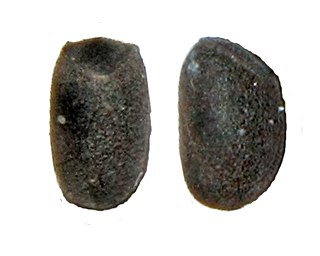
The Euphasmatodea, also known by its junior synonym Verophasmatodea is a suborder of the Phasmatodea, which contains the vast majority of the extant species of stick and leaf insects, excluding the Timematodea. The oldest record of Euphasmatodea is Araripephasma from the Crato Formation of Brazil, dating to the Aptian stage of the Early Cretaceous.

Phobaeticus is a genus of Asian stick insects comprising over 25 species.

Necrosciinae is a subfamily of the stick insect family Lonchodidae, with its greatest diversity in South-East Asia.

Ramulus is an Asian genus of stick insects in the family Phasmatidae and tribe Clitumnini.

Sipyloidea is a genus of stick insects of the family Lonchodidae. Species have been recorded from India, China, Indochina, through to Australasia. The genus was described by Brunner von Wattenwyl in 1893.

Diapheromera is a genus of stick insects in the family Diapheromeridae. There are about 14 described species in Diapheromera.

The Heteropterygidae is a family of stick insects belonging to the suborder Euphasmatodea. Species can be found in Australasia, East and Southeast Asia. More than 130 valid species have been described.

Pseudosermyle is a genus of walkingsticks in the family Diapheromeridae. There are more than 20 described species in Pseudosermyle.

Marmessoidea is an Asian genus of stick insects in the family Diapheromeridae and subfamily Necrosciinae. The native range of species appears to be from India and South-East Asia to the Wallace line.

Trachythorax is an Asian genus of stick insects in the family Lonchodidae and subfamily Necrosciinae. Species have been recorded from the Indian subcontinent, Indo-China, Malesia through to New Guinea.

The Clitumninae are a sub-family of stick insects in the family Phasmatidae found in Asia. The type genus Clitumnus is now considered a synonym of Ramulus.

The Lonchodinae are a subfamily of stick insects in the family Lonchodidae found in: Australasia, Asia, Africa, Southern America and the Pacific.
Ramulus westwoodii is a species of stick insect first described by James Wood-Mason in 1873 and named in honour of John O. Westwood.

The Gratidiini are a tribe of stick insects based on the type genus Clonaria and first used by Cliquennois in 2005. Genera are known to be distributed in: Africa, Europe, temperate and tropical Asia and various Pacific Islands.

The Platycraninae are an anareolate subfamily of stick insects in the family Phasmatidae. Their known distribution includes southern, southeast Asia and Australasia.

The Obriminae are the most species-rich subfamily of the Phasmatodea family Heteropterygidae native to Southeast Asia. It is divided into two tribe.

The Obrimini are the most species-rich tribe of the Phasmatodea family of the Heteropterygidae native to Southeast Asia.

The Cladomorphinae are a subfamily of stick insects in the family Phasmatidae. This taxon is particularly well represented in the Neotropical region, but records also exist for Madagascar, Java and the Maluku Islands.

Stenobrimus is a genus of medium-sized stick insects native to the Philippines.

Parapachymorpha is a genus of stick insects in the tribe Medaurini, erected by Carl Brunner von Wattenwyl in 1893. Species have been recorded from: China, Myanmar, Thailand, Cambodia and Vietnam.



















